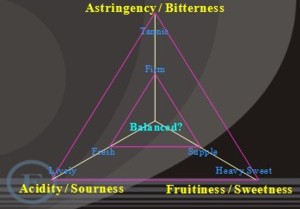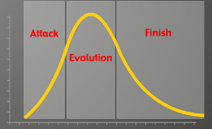This approach takes into account the lag in sequence of taste sensations, and structures it so that it becomes accurate and measurable. When you take a sip of wine, your first impressions are quite elementary--either you like it or you dislike it. If you allow the wine to remain in your mouth a few seconds longer, these first impressions are followed by secondary impressions, which should be similar to your first impressions. Lastly, when you swallow the wine, the final impressions should serve to confirm the taste impressions you had when the wine was in the mouth. Look at it this way: As the wine enters the mouth, it announces its presence with an initial impression. Call this the attack. You must then keep the wine on the tongue and concentrate on whether or not you receive continued stimulation. Call this the evolution.
Now, you look to see if the initial impression evolves or develops more flavor intensity. This may cover a short period of time (one second) or a longer one (four-to-five seconds), depending on the wine. Lastly, you look at the finish (aftertaste) of the wine. This is the stage where the wine impregnates your mouth with its final sensation, either a positive one or a negative one. The attack of a wine is judged in the first two seconds; the evolution occurs immediately after that and may last several seconds. Upon swallowing, the finish can be short-lived or long, depending upon the wine's concentration of flavor.
As a wine enters the mouth, the first impression you receive is the degree of sweetness in the wine - mostly because the tip of your tongue, which measures sweetness, is affected first. At this point, you must "wait a couple of seconds" before you can perceive the tingling sensation caused by the wine's acidity. Sweetness tends to retard your ability to perceive acidity, hence the slight time lag. Because the taste buds responsible for detecting bitterness are on the back of the tongue, a wine's bitterness isn't perceived until you actually swallow it.
Essentially, there are three elementary tastes responsible for a wine's flavor: sweetness, acidity, and bitterness. It is the interrelation of these elements that makes a wine tick!
All red wines, for example, have some sourness (per the grape acidity) and bitterness (per the grape tannins); and without the neutralizing effect of sweetness (grape sugars/alcohol), they would taste sharp and biting. When these elements are in good balance, you have an excellent wine. Some years, if the grapes don't ripen due to the lack of sunshine, they lack sufficient sweetness to balance-out the acidity and tannins present. The result is an unharmonious wine, slightly sour, with a rough finish.
Take a look at the diagram below. It was created by Andre Vedel to identify wine tasting terms that relate to the overall balance of wine.

Everyone's fingerprints are different and so are the ways their taste buds are configured. Hence, no one tastes a wine the same as everyone else. It is your personal taste that dictates quality—for YOU. You must learn to go with what you like. Pay no attention to anyone else!
What is important to me is that regardless of whether you like red, pink or white wine. Can you tell if the wine is balanced? If you can, you are way ahead of most consumers. Most consumers are doing just that—consuming rather than tasting.
Enjoy!

Featured Wine Tips & Videos






